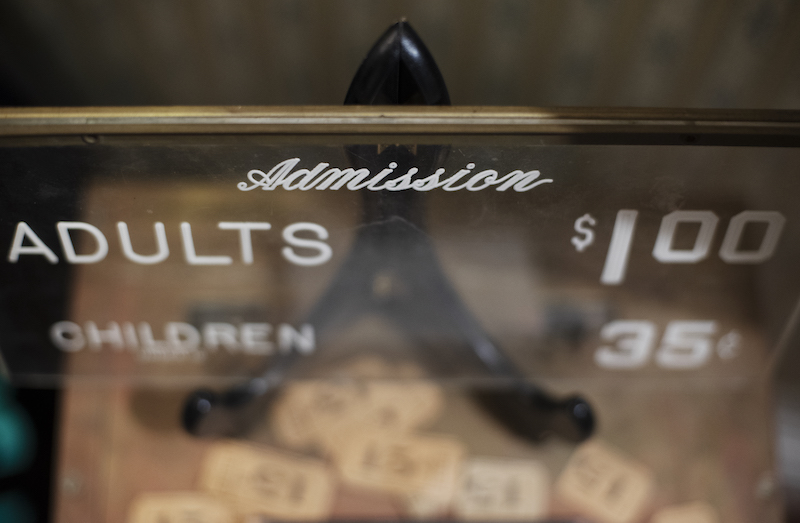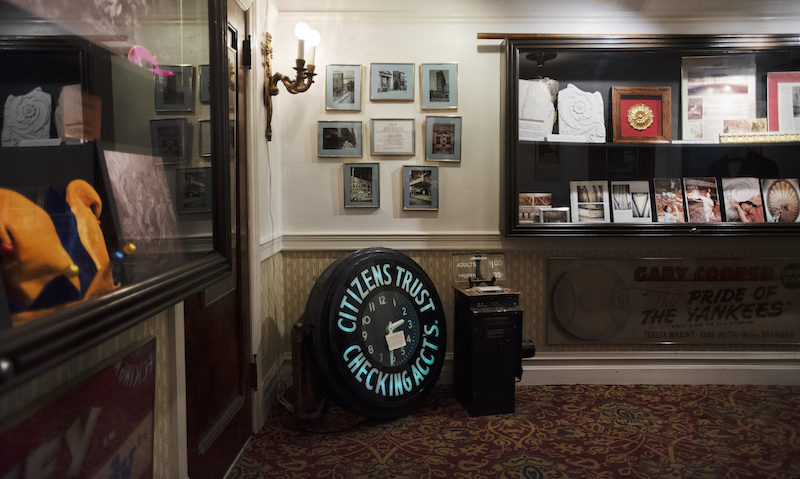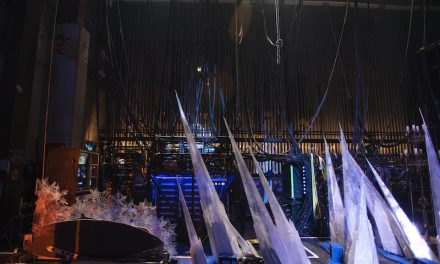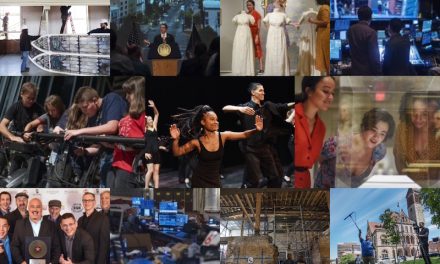Photos by Kate Penn
A program from opening night—Dec. 27, 1926—marvelously intact. A promotional folding fan, its back peppered with advertising from the days before TV, before the internet. An antique usher’s uniform. A royal chair, not so much a prop as an invitation, the theatre as temple.
These are just a few of the unique objects maintained by the Historical Committee at Proctors. Members John Scherer and Marilyn Sassi estimate the ultimate caché, from posters to pay stubs, to number in the neighborhood of 200,000. Scherer would know. Before joining the newly-formed committee in the early 1980s, his day job was curator of Decorative Arts and Popular Entertainment for the New York State Museum.

A ticket machine believed to date back to the early 1930’s and used in the front box office of Proctors is displayed in the Katherine S. Rozendaal Museum off the mezzanine of the MainStage at Proctors. The museum featues artifacts, articles and photos documenting the history of Proctors from the Historical Society. Photo taken Friday, June 7, 2019.
Showbiz is in his blood, if in a slightly different way than one often thinks.
“One of the first things I did as a member was to give my talk, ‘Musicals to Movie Palaces.’ I gave it in one of the rooms off the balcony here.”
On a recent Friday, Scherer—who is also president of Friends of Schuyler Mansion and historian for the town of Clifton Park—sat with Sassi and fellow committee member Pam Dodds around a makeshift card table desk, sharing memories, ticking off facts and scavenging for ephemera. There was plenty of laughter, and serious moments, too.
The trio was also just off the Proctors mezzanine, in the Kay S. Rozendaal Theatre Museum. A mannequin greets you to your left, in an ersatz dressing room diorama, before a step down brings you into what was once the theatre manager’s office.
The topic at hand was the museum itself. A hidden gem certainly, but free and open to visitors before shows and during intermission at most Proctors performances.

Historical Proctors memorabilia is displayed in the Katherine S. Rozendaal Museum off the mezzanine of the MainStage at Proctors. The museum featues artifacts, articles and photos documenting the history of Proctors from the Historical Society. Photo taken Friday, June 7, 2019.
“We actually have the theatre manager’s books from the 1930s,” Scherer marveled, “which recorded each of the vaudeville acts that appeared here, as well as all the movies. It’s fun to go back through them, because you see Red Skelton’s name, and George Burns and Gracie Allen, and Bob Hope. They were all here.”
The museum, named for the civic and community leader so important to saving Proctors in the late 1970s, has, of course, a history of its own. Spurred by a Junior League research project, it opened March 25, 1984, its ribbon cut by legendary actor and Proctors supporter Hal Holbrook.
It’s small but mighty. According to Sassi, who joined the committee in 2004, the main display is changed each year, giving visitors a chance to reflect on different aspects of the theatre’s grand history (which is also shown in arcade windows and vitrines just outside the museum).
Dodds, a retired administrative assistant, is the organizer in the bunch, the one who keeps track of even the tiniest details. She immediately produced a list of some of the past themes presented in the Rozendaal, including Charlie Chaplin, movie magazines, Kirk Douglas, original key fobs, “Gone with the Wind,” Mickey Rooney and Goldie, the mighty Wurlitzer theatre organ.
“I make copies of everything,” she admitted with a wink.
While the members don’t have titles, they do take the gig seriously. Each, along with others not at the meeting, is a virtual wellspring of information about Proctors, its performers, the buildings’ tales, its ghostings and its quirks.

The original blueprint for Proctor’s Theatre from 1926 by Thomas Lamb, architect, hangs in the Katherine S. Rozendaal Museum off the mezzanine of the MainStage at Proctors. The museum featues artifacts, articles and photos documenting the history of Proctors from the Historical Society. Photo taken Friday, June 7, 2019.
Sassi, like Scherer, worked in the biz, including an eight-year stint with Schenectady Historical Society and rounds at Fulton County Museum and the Van Alstyne Homestead Society in Canajoharie. Long before the aforementioned internet, the Electric City was a real theatre town, and Sassi went to many and knows of even more. Proctors, of course, is her favorite and she delights in showing it off.
“I love doing exhibits,” she crowed, waving her hand like an earnest game show model past a current display of theatre restoration photos. “That’s one of my favorite things.”
In the Rozendaal now, a small side table sits below a vitrine. On its own, it’s not much. But a tag notes it as an original dressing room table from the vaudeville days, and a glance immediately sparks a conversation.
“People like to reminisce when they come in,” Scherer said.
That’s actually the great joy of the museum, its role as a forum. Scherer loves to learn new things from visitors, some whose memories reach back further than his own. Sassi’s eyes widen with wonder as she relates a curious anecdote for a first-time visitor. And Dodds, a bit quieter than the other two, brightens when she can provide a detailed answer to a winsome query.
“My favorite thing is that playbill from opening night,” she said. “When we got that it was absolutely wonderful. It was amazing that it survived and somebody found it.”
If a visit to the Rozendaal Museum tickles your fancy enough to dig deeper, the Historical Committee at Proctors welcomes new members. Contact chairperson Audrey Hughes via the administrative office at 518.382.3884.
By Michael Eck
Proctors publishes The Collaborative. All content featured in the Proctors Collaborative section is written by employees of the organization.





